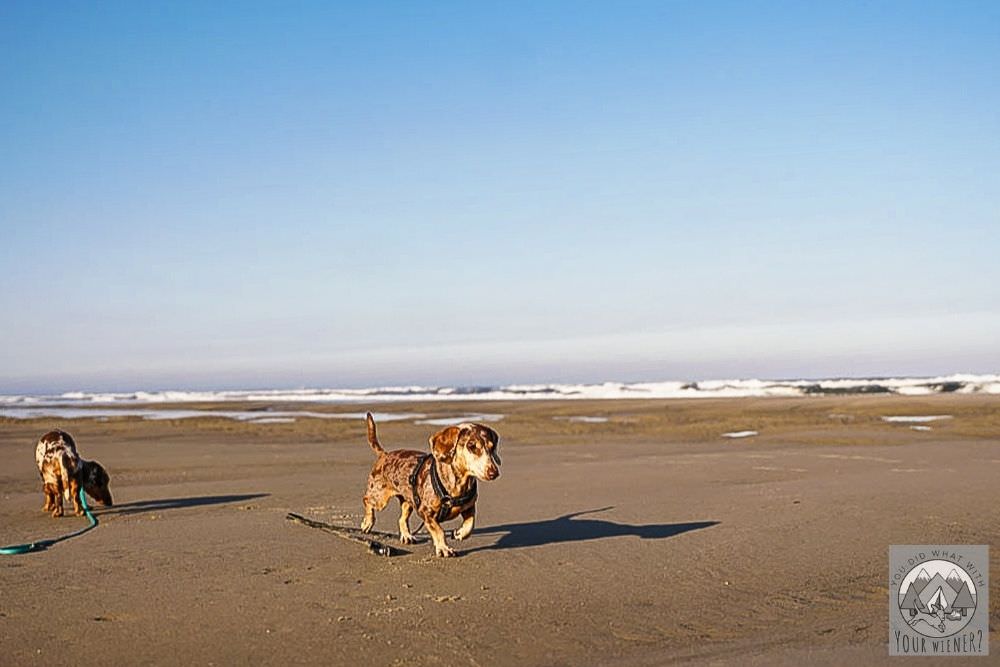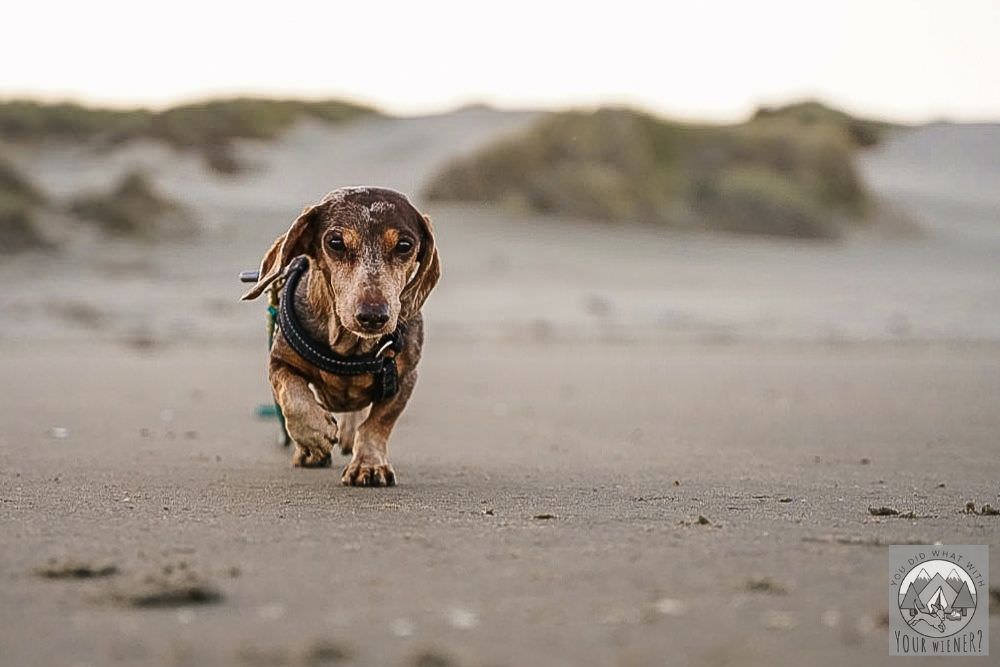A luxating patella is a common condition in dogs but is especially prevalent in small breeds like Dachshunds.
It usually becomes noticeable around 4-6 months of age, and it’s often a congenital defect.
Dachshunds have a predisposition for luxating patella, and it can normally be diagnosed and treated early on.

What is a Luxating Patella?
The word “patella” refers to the kneecap. “Luxating” means out of place.
Therefore, a luxating patella is an out of place, or dislocated, kneecap.
Luxating patella occurs when your dog’s kneecap moves in and out of its normal location.
Dog parents often notice a luxating patella when their dog is walking or running then skips, lifts a specific leg for a step or two, then places it back down on the ground to continue moving forward.
What Causes a Luxating Patella?
Your Dachshund’s kneecap sits just underneath the patellar ligament. It attaches the thigh muscles to the front and center of the shin bone.
When your dog is running or walking, the thigh muscles will contract.
The force from the contraction is then transmitted through the patellar ligament, which then pulls on the shin bone (or tibia).
After this occurs, the knee extends or straightens, and your Dachshund’s patella will slide up and down into the proper groove in order to keep the ligament in place.
Over long periods of time with abnormal movement, the groove in the femur can wear down.
After this happens, the patella can then dislocate, or slide toward the inner part of the knee, rather than back into its groove.
Small dogs with bowed legs may be especially prone to having a luxating patella.
Many dogs, especially small dogs with bowed legs, are prone to a luxating patella, because the point of the patellar ligament attachment is NOT in the center of the shin bone like it should be.
Dachshunds, because they are genetically dwarves, can have deformed legs that are bowed.
If their legs are bowed, the patellar ligament is often located too far toward the middle of their body, or near the inside of the leg.
Signs and Symptoms of a Luxating Patella
A luxated patella affects every dog differently.
The main sign that your Dachshund has a luxating patella is the skipping while running, as we discussed at the beginning of the article.
While walking or running, you may notice your Dachshund lift one leg, skip a step or two, then place it back down on the ground to continue moving forward.



There can be long term effects of a luxating patella in Dachshunds depending on the severity.
While some dogs can thrive for a lifetime with a luxating patella, others will face a more difficult road.
Over time a severe luxating patella can lead to:
- Other knee injuries, including torn ligaments
- Changes to the hip, thigh and shin bones from bearing weight unevenly
- Arthritis, which can cause joint pain and decreased mobility
If you suspect your dog of having luxating patella, the best course of action is to take them to the vet.
Signs and symptoms of a luxating patella in Dachshunds differ per individual case.
However, some common symptoms are:
- An unusual gait (walking weird)
- Limping
- Abnormally carrying a leg or legs
- Inability to bend the knee
- Shown signs of pain when moving the leg
- Reluctance to run or jump
- Refusing to go for a walk
If you’re noticing consistent skipping or lameness, take your Doxie to the vet for a medical examination.
How Bad Is Your Dog’s Luxating Patella?
There are different grades (Grade I-IV) to measure the severity of a luxating patella, and it can affect one or more legs.
These are, in summary:
- Grade 1: Manually the patella easily luxates at full extension of the stifle joint, but returns to the trochlea when released. Flexion and extension of the stifle are in a straight line with no abduction of the hock.
- Grade 2: There is frequent patellar luxation, which, in some cases, becomes more or less permanent. The limb is sometimes carried, although weight bearing routinely occurs with the stifle remaining slightly flexed. Many dogs with this grade live with the condition reasonably well for many years, but the constant luxation of the patella over the medial trochlear ridge of the trochlea causes erosion [and further degradation over time]
- Grade 3: The patella is permanently luxated with torsion of the tibia and deviation of the tibial crest of between 30 degrees and 50 degrees from the cranial/caudal plane. Although the luxation is not intermittent, many animals use the limb with the stifle held in a semi-flexed position.
- Grade 4: The tibia is medially twisted and the tibial crest may show further deviation medially with the result that it lies 50 degrees to 90 degrees from the cranial/caudal plane. The patella is permanently luxated. The patella lies just above the medial condyle and space can be palpated between the patellar ligament and the distal end of the femur. The limb is carried, or the animal moves in a crouched position, with the limb flexed.
If a luxating patella is something your dog was born with, your vet may catch it during one of their first couple checkups.
If your dog has gradually developed a luxating patella, it often won’t be caught until it’s bad enough to cause regular pain or lameness, which results in you taking your dog to the vet to find out what’s wrong.
Either way, once your dog is diagnosed with a luxating patella, a veterinarian will assess the grade of the condition based on the criteria above.
Is Luxating Patella Common in Dachshunds?
The short answer is yes.
As described above, a luxating patella is common in Dachshunds because it’s common for their short, dwarfed legs to be bowed (to varying degrees).
Small breeds of dogs are most susceptible to patellar luxation for this reason.
Dachshunds not only have bowed legs, but they are also incredibly short, leaving very little room for movement error.
Other breeds who battle a similar issue are the Bichon Frise and Maltese.
All of these breeds have short legs that tend to bow outwards.



Treatment Options for a Luxating Patella
Surgery is available to correct a luxating patella, but it’s only performed for Grades II-IV.
Grade I luxating patellas aren’t typically surgically repaired.
When a luxating patella is surgically repaired, the point of attachment of the ligament is transplanted to its proper location.
Sometimes implants are used to reinforce the patella.
A luxating patella post-surgery recovery is generally rapid, especially with pain management and appropriate aftercare.



Alternatives to Surgery for a Luxating Patella
Putting your Dachshund through surgery can be a terrifying thought, especially if they are a puppy or in their senior years.
Thankfully surgery isn’t always necessary, and there are a few things you can do as a dog parent to make things a little easier for your Doxie.
Joint Supplements
Joint supplements can help strengthen muscles and joints, reducing pain and increasing mobility.
Supplements for joint health (affiliate link) are specifically designed to promote cartilage build up and alleviate daily pain.
Anti-inflammatory medication can help with pain your dog is having.
Prescription Medications
Your Doxie’s vet can prescribe anti-inflammatories to assist with pain and discomfort included by a luxating patella.
Never give your Dachshund human medications such as Tylenol or ibuprofen. Instead, contact your veterinarian to discuss options.
Losing Weight
Obesity can be a factor in how a Dachshund handles luxating patella.
You may find that the condition improves if your Dachshund loses weight, and gets into better shape.
Excess weight puts unnecessary pressure on joints, so losing it can improve several bodily functions.
You may feel like your Dachshund shouldn’t heavily exercise if they have a luxating patella.
If your vet has determined that your dog doesn’t need corrective surgery, normally exercise is still okay.
Walking is still recommended regardless of a luxating patella.
You should still walk your dog if they have a luxating patella, you’ll just need to observe if symptoms become worse.
Knee Brace
Knee braces can be worn to help with healing and stability after surgery.
Braces can also help relieve inflammation, and provide balance while walking.
Talk to your veterinarian to see if a knee brace could potentially help your Dachshund with a luxating patella.



Final Thoughts
A luxating patella in Dachshunds can be extremely painful and debilitating, or it can be a lifelong condition that never truly affects them.
Either way, it’s important to give your Doxie the best care they need to live as healthy and happy as possible.
Meet with your veterinarian to discuss treatment options once you’ve reached a definitive diagnosis.
Ultimately, the prognosis for a luxating patella is great, so it comes down to the best approach and plan for your beloved Dachshund.
Comments
Post a Comment